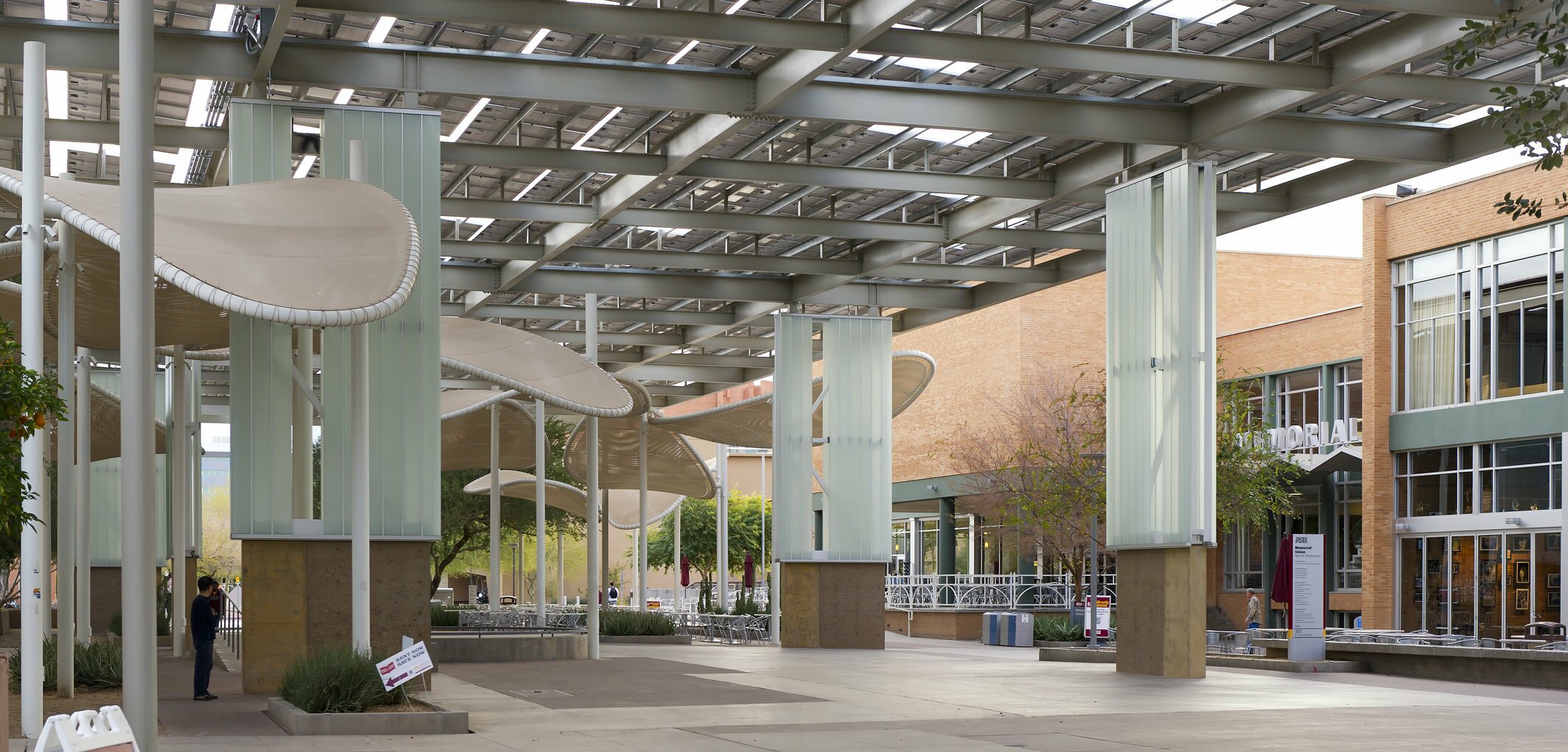Quest for Shade
In many places in Arizona the sun reaches the ground about 300 days each year as determined by the National Climate Data Center. In wintertime, Arizona’s sunny climate is the envy of places like Cleveland, Buffalo or Portland. Having spent considerable time in past years on business to the Pacific Northwest, I can attest to the seeming relentless shroud of winter mist and drizzle, which sends residents of Portland and Seattle off to tanning salons for therapy.
Come late-spring and summer, however, climate fortunes reverse. Arizona’s sunshine becomes -- well, too much. Parking a car at a shopping mall in June is an exercise of locating a space beneath a tree or behind whichever building casts the most shade. Students taking summer classes on ASU’s Tempe campus must endure the sun’s direct rays as they move about campus in 110 degree temperatures. Adding fuel to the fire, heat is further reflected and radiated from buildings and concrete malls between buildings. It’s a densely-packed and scorching heat island. It puts literal meaning in being a Sun Devil.
The constant sun beating down on ASU is also perfect for harnessing sunlight for electricity.
So, ASU’s visionary president, Michael Crow turned to the innovative brain trust of the nation’s largest university to take advantage of Arizona’s sunshine to transform the main campus into the leading institution for sustainable energy. A visitor to ASU will see parking garages throughout campus topped with massive solar arrays producing power for campus use and conveyed to the electric grid.
As part of ASU’s renewable energy transformation, a new start-up company, Strategic Solar Energy, LLC, has initiated several highly creative solar projects that bring new meaning to solar energy in Arizona. SSE’s PowerParasol concept of community-level solar arrays provides more than solar energy. The innovative “solar wind sail” projects at ASU combine solar power with shade canopies and advertising opportunities. Three PowerParasol projects are currently under construction at ASU-Main.
I recently had the opportunity to tour the ASU projects and came away impressed by their functionality and architectural fit and beauty.
Thanks to the 5.25 acre PowerParasol canopy covering 800 parking spaces commuting students banished to the infamous “Lot 59” for parking can now return to their cars without fear of touching steering wheels that have been seared to branding-iron temperatures. In addition to shielding cars from direct rays of the sun, the Lot 59 PowerParasol, which is up and running, produces 3.7 million kWh of power annually.
 Likewise, the shade canopy of the PowerParasol outside Memorial Union on Cady Mall with its built-in glass and l-e-d lighting features creates a venue with ambience for outdoor entertainment and dining, while also generating 679 thousand kWh of electricity. The MU/Cady Mall project will be completed in January of 2014.
Likewise, the shade canopy of the PowerParasol outside Memorial Union on Cady Mall with its built-in glass and l-e-d lighting features creates a venue with ambience for outdoor entertainment and dining, while also generating 679 thousand kWh of electricity. The MU/Cady Mall project will be completed in January of 2014.
A third PowerParasol is currently under construction on Gammage Parkway behind the Frank Lloyd Wright-designed Gammage Auditorium. It will shade the entire 800 foot length of the parkway from Mill Avenue to Forest Ave., with creative night-lighting on the roadway and structures to hold banners advertising Gammage events and other campus activities. The shaded median will create a gathering place of over one acre before and after plays, concerts and other events at Gammage and the nearby ASU music auditorium. This project will produce 846,716 kWh of electricity.
PowerParasol structures are elevated 22-32 feet above the ground (depending on architectural and engineering requirements) with steel and concrete support structures built for aesthetic light and advertising opportunities. The project design enables some light to filter down from the solar panels through strategically placed open spaces among the panels. By allowing dappled sunlight to reach the ground, areas beneath the structures can be landscaped with vegetation. The solar canopies also create a mini-climate underneath the tall structures, enabling ground-level heat to rise and cooler air to flow toward the ground, which is great for outdoor gatherings and tail-gating in Lot 59, opposite Wells Fargo Arena and Sun Devil Stadium.
PowerParasol is a new way of making solar energy economically sustainable by combining multiple uses and revenue streams in commercial applications. The architectural design makes these projects aesthetically pleasing and landscape-compatible without the harsh industrial look of bare steel and glass. PowerParasol is a great fit for commercial, institutional and planned community developments seeking applications of solar energy. SSE’s business plan seeks to partner with Arizona’s utility companies in the construction, ownership and grid integration of PowerParasol projects. Additionally, the large-scale construction and multiple revenue streams attached to PowerParasol projects means these renewable energy projects will be able to stand-on-their own economically without the massive subsidies required by their much smaller solar cousins -- rooftop solar.
